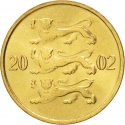You are about to finish your registration. Please check your mailbox (including spam folder). There should be a letter with a confirmation link. Check setting to make sure that your e-mail address is correct.
Send letter againDescription
Engraver: Georg Vestenberg
Obverse

|
Depicts three passant-gardant lions from the coat of arms of Estonia (1925–1940), within a shield dividing the issue year. 19 31 |
|---|---|
Reverse

|
Depicts the denomination with the country name (Republic of Estonia) above. · EESTI VABARIIK · |
| Edge |
Characteristics
| Material | Nickel Bronze |
| Weight | 2.5 g |
| Diameter | 17.75 mm |
| Thickness | - |
| Shape |
|
| Alignment | Medal |
| Mint |
Estonian State Printing Office
|



